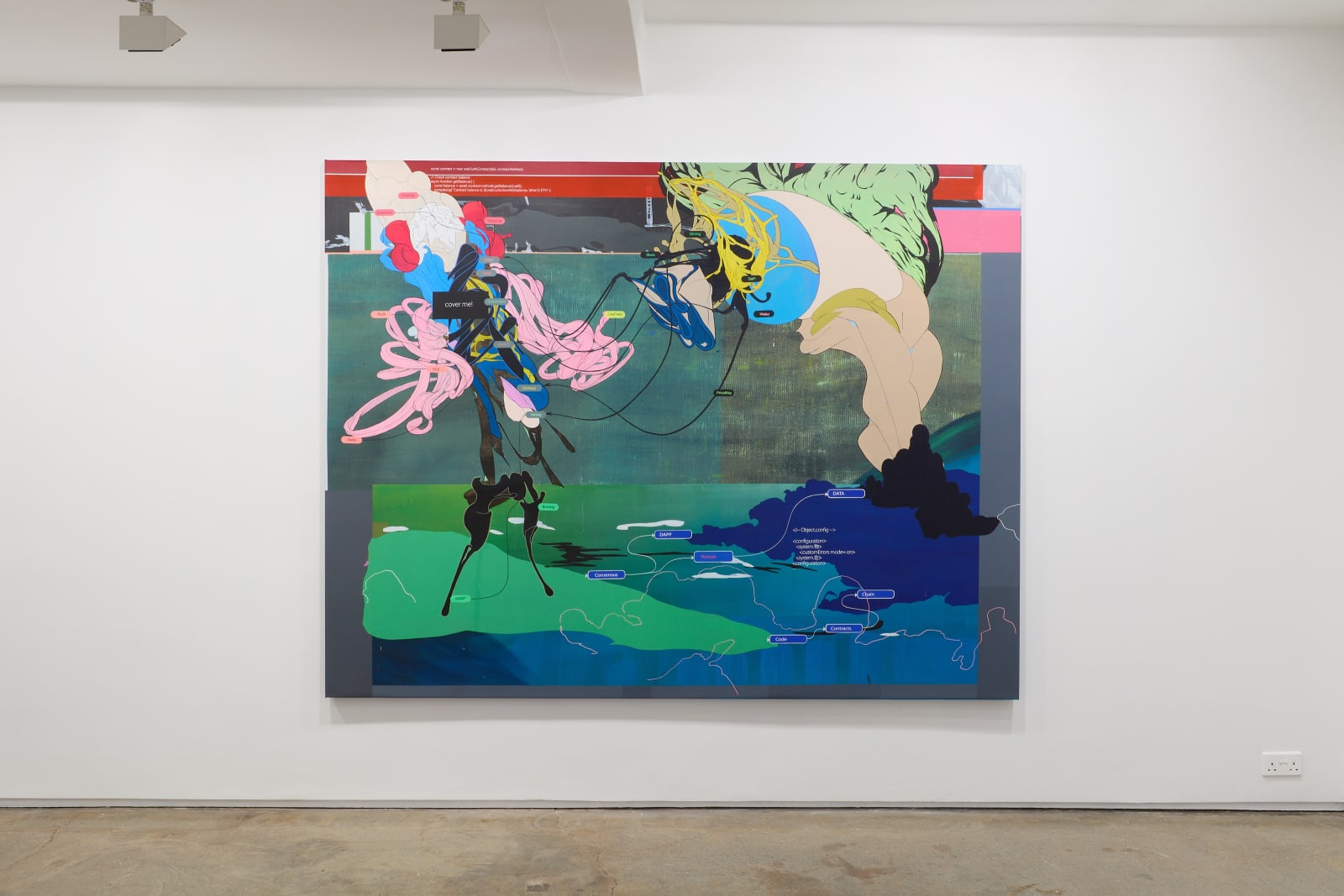Zhong Wei: Patch Notes
Past exhibition
Overview
Larkin Durey is delighted to present an exhibition of new work by Zhong Wei. This is the artist’s third solo show with the gallery.
For several years, Wei has been learning computer programming and the application and deployment of artificial intelligence technologies. During this process, he has focused on the key technologies that are widely used in the production of goods, such as chips based on transistors, the interaction between computer operating systems and hardware layers, the syntax and logic of programming language and its interaction principles with computer hardware, and open-source technologies. These studies have profoundly influenced his perception of the modern world and his desire to reflect the experience of living in such an environment through painting.
This exhibition features work from the artist’s Hello World and Thing series.
In the Thing series, the artist depicts various human seeming "information monsters." By placing them in backgrounds with a visual network of informatization, Wei attempts to portray the deconstruction and alienation of humans by computers, the internet, and modern productivity in the context of networked existence. The Thing series is usually narrative in nature.
In the Hello World series, Wei endeavours to use the language of abstract painting to depict the code world ubiquitous to contemporary life. From mechanical assembly line production and various smart appliances, to the screen information that occupies most of our time and rapidly developing artificial intelligence, Wei demonstrates how these elements that are shaping modern civilization are fundamentally based on various computer languages. The textural layers of the paintings explore the different languages at the heart of daily computer interface interactions, in computer graphic software and in the structure of human society itself. Similarly, the numerous straight lines cutting through the images are inspired by the experience of using screens, the ways in which these devices violently fragment people’s time and how forced efficiency has led to the fragmentation of social life and our ability to retain information.
In all of his recent work, Wei has started to incorporate elements of mind maps, which he has noticed becoming increasingly popular for handling the vast amounts of information assailing our senses. From learning computer technology and AI knowledge to career or life planning, mind maps or logical visualization methods are fundamentally shaping people's ways of understanding. Wei sees these diagrams as a linking medium between the ways in which humans function and machine led manufacturing processes.
Zhong Wei was born in Beijing, China in 1987. His work has been acquired by the Museum of Modern and Contemporary Art in Nasantara (MACAN), Indonesia.
For several years, Wei has been learning computer programming and the application and deployment of artificial intelligence technologies. During this process, he has focused on the key technologies that are widely used in the production of goods, such as chips based on transistors, the interaction between computer operating systems and hardware layers, the syntax and logic of programming language and its interaction principles with computer hardware, and open-source technologies. These studies have profoundly influenced his perception of the modern world and his desire to reflect the experience of living in such an environment through painting.
This exhibition features work from the artist’s Hello World and Thing series.
In the Thing series, the artist depicts various human seeming "information monsters." By placing them in backgrounds with a visual network of informatization, Wei attempts to portray the deconstruction and alienation of humans by computers, the internet, and modern productivity in the context of networked existence. The Thing series is usually narrative in nature.
In the Hello World series, Wei endeavours to use the language of abstract painting to depict the code world ubiquitous to contemporary life. From mechanical assembly line production and various smart appliances, to the screen information that occupies most of our time and rapidly developing artificial intelligence, Wei demonstrates how these elements that are shaping modern civilization are fundamentally based on various computer languages. The textural layers of the paintings explore the different languages at the heart of daily computer interface interactions, in computer graphic software and in the structure of human society itself. Similarly, the numerous straight lines cutting through the images are inspired by the experience of using screens, the ways in which these devices violently fragment people’s time and how forced efficiency has led to the fragmentation of social life and our ability to retain information.
In all of his recent work, Wei has started to incorporate elements of mind maps, which he has noticed becoming increasingly popular for handling the vast amounts of information assailing our senses. From learning computer technology and AI knowledge to career or life planning, mind maps or logical visualization methods are fundamentally shaping people's ways of understanding. Wei sees these diagrams as a linking medium between the ways in which humans function and machine led manufacturing processes.
Zhong Wei was born in Beijing, China in 1987. His work has been acquired by the Museum of Modern and Contemporary Art in Nasantara (MACAN), Indonesia.
Works
Installation Views
















